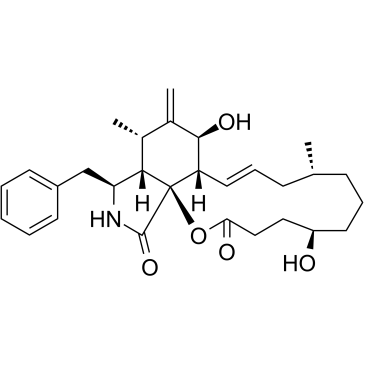2-Hydroxymethyl-1-naphthol diacetate (TAC) suppresses the superoxide anion generation in rat neutrophils.
J P Wang, L T Tsao, A Y Shen, S L Raung, L C Chang
Index: Free Radic. Biol. Med. 26(7-8) , 1010-8, (1999)
Full Text: HTML
Abstract
We have investigated the inhibitory effect of 2-hydroxymethyl-1-naphthol diacetate (TAC) on the respiratory burst of rat neutrophils and the underlying mechanism of action was also assessed in this study. TAC caused concentration-related inhibition of the formylmethionyl-leucyl-phenylalanine (fMLP) plus dihydrocytochalasin B (CB)- and phorbol 12-myristate 13-acetate (PMA)-induced superoxide anion (O2*-) generation (IC50 10.2+/-2.3 and 14.1+/-2.4 microM, respectively) and O2 consumption (IC50 9.6+/-2.9 and 13.3+/-2.7 microM, respectively) of neutrophils. TAC did not scavenge the generated O2*- during dihydroxyfumaric acid autoxidation. TAC inhibited both the transient elevation of [Ca2+]i in the presence or absence of [Ca2+]o (IC50 75.9+/-8.9 and 84.7+/-7.9 microM, respectively) and the generation of inositol trisphosphate (IP3) (IC50 72.0+/-9.7 microM) in response to fMLP. Cytosolic phospholipase C (PLC) activity was also reduced by TAC at a same range of concentrations. The PMA-induced PKC-beta associated to membrane was attenuated by TAC (about 80% inhibition at 30 microM). Upon exposure to fMLP, the cellular cyclic AMP level was decreased in neutrophils pretreated with TAC. TAC attenuated fMLP-induced phosphorylation of mitogen-activated protein kinase (MAPK) p42/44 (IC50 17.4+/-1.7 microM), but not p38. The cellular formation of phosphatidic acid (PA) and, in the presence of ethanol, phosphatidylethanol (PEt) induced by fMLP was inhibited by TAC in a concentration-dependent manner (IC50 25.4+/-2.4 and 25.9+/-1.4 microM, respectively). TAC had no effect on the O2*- generation of PMA-stimulated and arachidonic acid (AA)-stimulated NADPH oxidase preparations. However, TAC caused concentration-related decrease of the membrane associated p47phoX in PMA-stimulated neutrophils (about 80% inhibition at 30 microM). We conclude that inhibition by TAC of the neutrophil respiratory burst is probably attributable to the blockade of the p42/44 MAPK and phospholipase D (PLD) pathways, the membrane translocation of PKC, and to the failure in assembly of a functional NADPH oxidase complex. Blockade of the PLC pathway by TAC probably plays a minor role.
Related Compounds
| Structure | Name/CAS No. | Molecular Formula | Articles |
|---|---|---|---|
 |
Dihydrocytochalasin B
CAS:39156-67-7 |
C29H39NO5 |
|
Tetraploidization increases sensitivity to Aurora B kinase i...
2012-07-01 [Cell Cycle 11(13) , 2567-77, (2012)] |
|
Centrifugal and chromatographic analyses of tryptophan and t...
2003-02-28 [J. Biochem. Biophys. Methods 55(2) , 127-40, (2003)] |
|
Degradation and recycling of the substrate-binding subunit o...
1996-07-05 [J. Biol. Chem. 271(27) , 16369-74, (1996)] |
|
Complex regulation of human neutrophil activation by actin f...
1997-06-01 [J. Leukoc. Biol. 61(6) , 703-11, (1997)] |
|
Disruption of the actin cytoskeleton leads to inhibition of ...
2000-08-25 [Exp. Cell Res. 259(1) , 35-53, (2000)] |